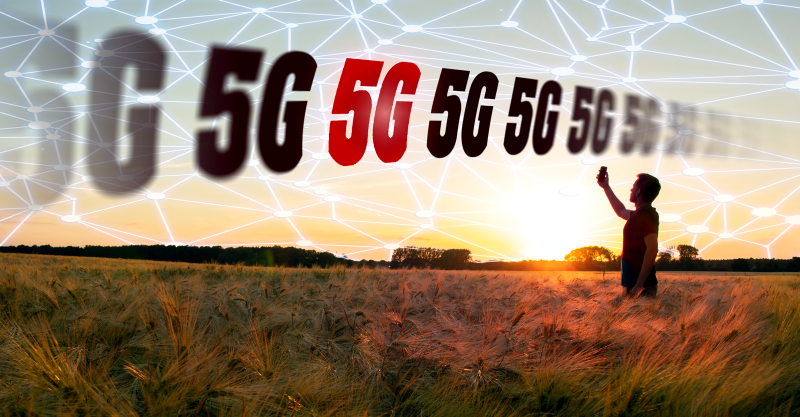5G Fund for Rural America Hands Over U.S. Farms to Big Tech, Critics Say
FCC’s new fund includes money for precision agriculture that opponents say is more about commodification and control of information than better farming.
The Federal Communications Commission (FCC) last week established the 5G Fund for Rural America. The fund will hand over billions of dollars worth of taxpayer money to the world’s largest telecom providers. In exchange, the telecom giants will build 5G infrastructure in rural regions of the U.S. — including the infrastructure needed for 5G or wireless farming, also known as “precision agriculture.”
Precision agriculture involves the use of sensors in fields to measure moisture and temperature levels, satellites and drones that provide remote real-time images of crops, and even wireless sensors attached to cattle that monitor their health and track their location.
Proponents of precision agriculture see it as a path towards increased profitability, sustainability and the ability for farmers to determine the exact optimal amount of water, fertilizers or pesticides.
But critics say it’s simply a “marriage between agribusiness and spy technology.”
“Precision farming is about commodification and control of information and it is among the high-tech tools that are driving the industrialization of agriculture, the loss of local farm knowledge and the erosion of farmers’ rights,” Hope Shand, research director for ETC Group, told CorpWatch.
Global Research, in its report, “5G Agriculture – Food from Frankenstein Farming,” described “5G food” as a “GMO look-alike” and concluded that 5G agriculture “is just one more toxic scam within the egregious global roll-out of 5G — and its attempt to monitor, control and irradiate all that lives, breathes and has the expectation of a life worth living.”
The FCC will hold two rounds of reverse auctions to distribute up to $9 billion for deploying 5G networks in the country’s rural areas. Telecom companies like Verizon and AT&T and satellite companies like SpaceMobile and Lynk are eligible to bid during the reverse auction.
The 5G fund follows in the steps of a smaller U.K. initiative called “5G Rural First,” where the U.K. government gave Cisco £$5.5 million ($7.1 million) to “[run] a number of different 5G experiments in rural areas” across the country.
Both 5G Rural First and the new U.S. 5G Rural Fund are dependent on the Internet of Things (IoT) devices to support communication between the farm and the rest of the world. The IoT involves an exponential increase in devices connected to the internet — broadening the domain of internet connectivity from phones and computers, to everything — heaters, dishwashers, home security systems, self-driving cars, refrigerators, traffic lights, trash cans, water systems, “smart roads,” and yes, even diapers.
This expansion of internet-connected items needs 5G to facilitate the speed and higher bandwidth capacity transmission required to carry all of the data, according to the FCC. “5G will help enable cutting edge applications … [like] the Internet of Things and other novel ideas we can’t conceive today,” said FCC Chairman Ajit Pai while announcing the FCC’s 5G Fast Plan.
But in addition to contributing to increased wireless radiation exposure, 5G precision agriculture has the potential to extract unprecedented amounts of valuable data, opponents argue. This means that in addition to health risks, 5G rollouts bring a new era of surveillance and potential abuse by governments and corporations with this data.
“These technologies could lead to rapid integration of data and provide near-continuous, persistent monitoring of virtually anywhere we choose,” said former-CIA Director David Petraues about the IoT in 2012. In 2016, then-Director of National Intelligence James Clapper explained that, “in the future, intelligence services might use the loT for identification, surveillance, monitoring [and] location tracking …”
The 5G Fund for Rural America comes amidst a nationwide push for building the country’s 5G infrastructure. In June, AT&T expanded its low-band 5G coverage and in September, T-Mobile boosted its mid-band 5G coverage. In October, after Verizon’s plan to rely on millimeter waves for its 5G failed and the company changed its strategy to use its 4G LTE network (DSS 5G), which enabled it to expand its 5G service quickly, Verizon officially announced a nationwide 5G network. At the same time, the telecom giant launched its “Verizon 5G Home.”
The recent FCC order is the actualization of what the U.S. has long advertised 5G would be from the very beginning.
“We must reject any notion that the 5G future will be the sole province of urban areas,” declared then-FCC Chair Tom Wheeler in 2016. “The 5G revolution will touch all corners of this country.”
But according to Dafna Tachover, director of Children’s Health Defense’s 5G and Wireless Harms Project:
“The FCC-promised ‘revolution’ is an existential threat to the many who have been injured by the current wireless infrastructure. The forced and aggressive expansion of 5G, including in rural areas, is making it impossible for those who have been injured, including many children, to find a liveable place to escape this highly toxic radiation.
“In our lawsuit against the FCC, we cite thousands of studies showing that the FCC’s position is contrary to the clear scientific and human evidence and fails to protect public health.”
Sign up for free news and updates from Robert F. Kennedy, Jr. and the Children’s Health Defense. CHD is implementing many strategies, including legal, in an effort to defend the health of our children and obtain justice for those already injured. Your support is essential to CHD’s successful mission.


No comments:
Post a Comment